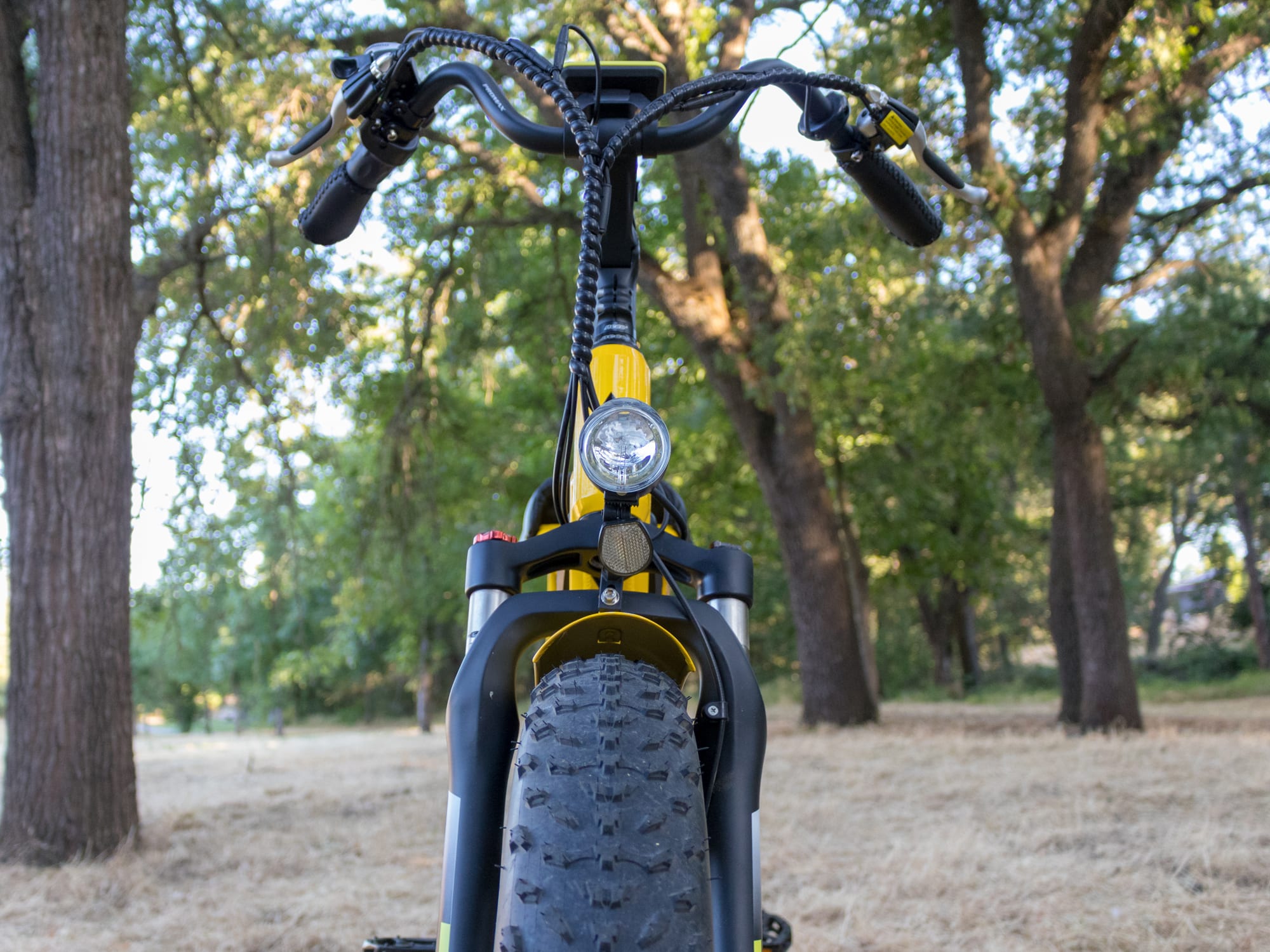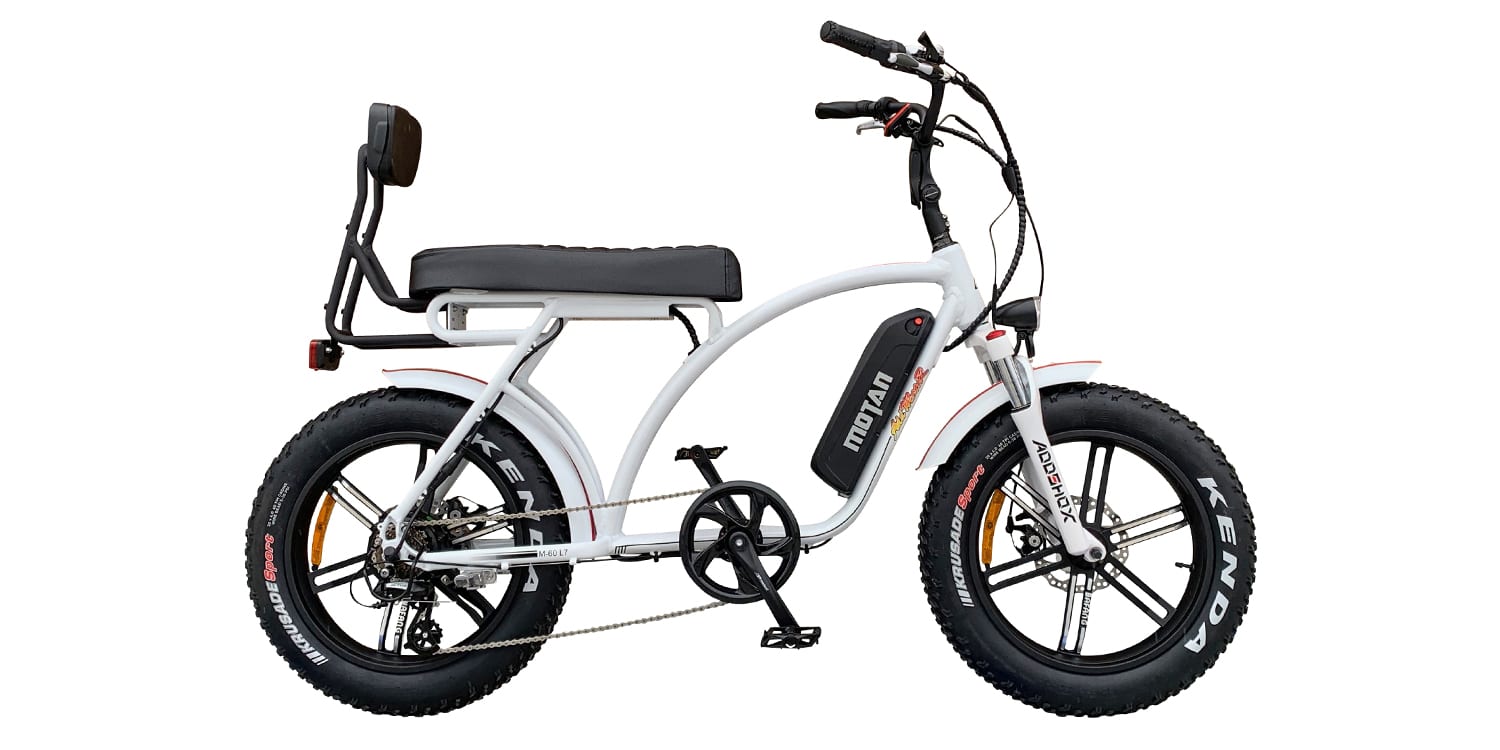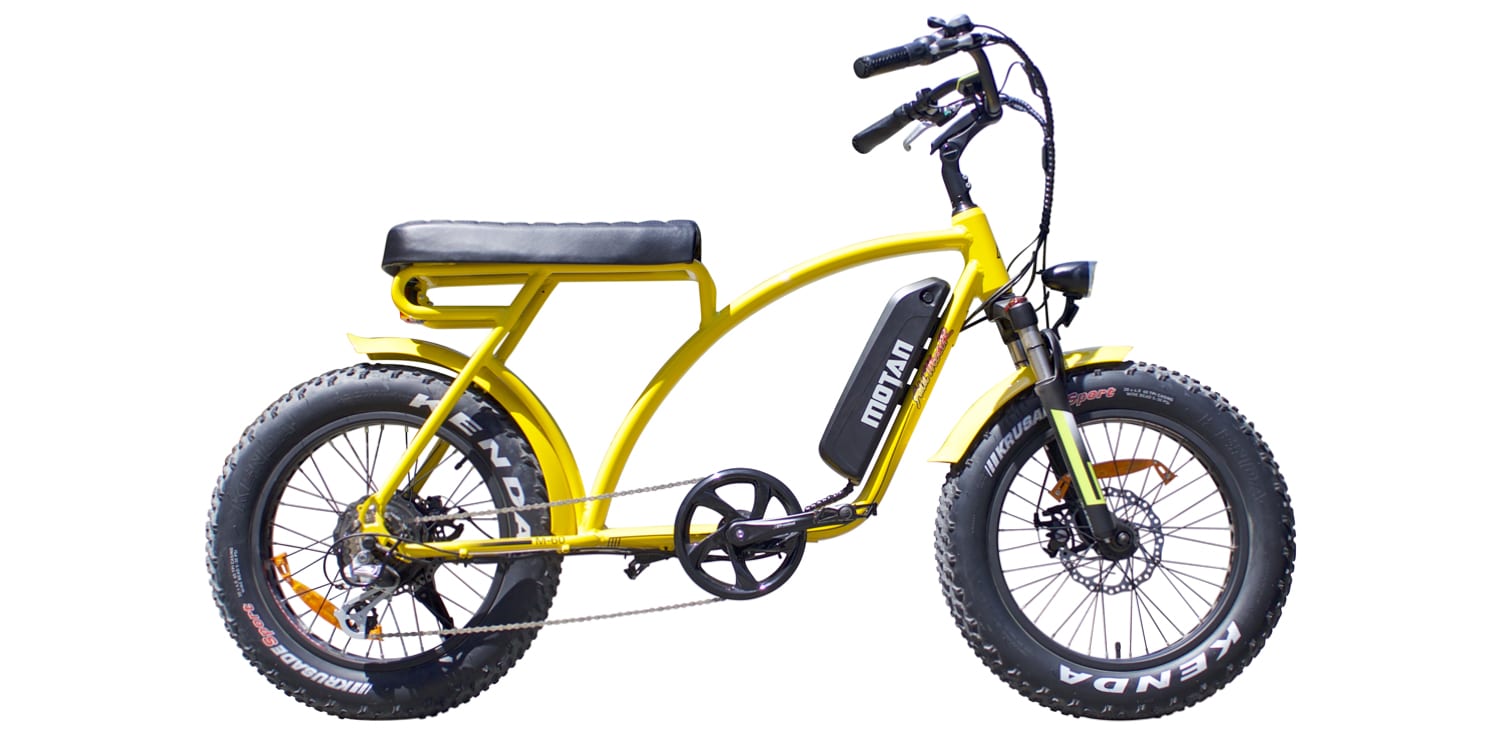EBR charges a service fee to manufacturers to produce ebike reviews and videos, this began in 2018. It’s the same flat fee for each bike, and it helps us to keep the site going while limiting ad clutter. We appreciate the opportunity to serve you with our opinions and data but respect your right to know that we receive compensation :)
Hi there! Brent here. The MOTAN M-60 from AddMotoR is a pretty sweet ride and leaves me wishing I lived by a beach. At first glance it seems rather compact, but it’s actually pretty long at 70 inches in length, although the high-rise swept back handlebars do keep the width relatively narrow at just 24 inches. This electric bike reminds me a lot of the Super 73, which Court reviewed in October of 2017. Since they look and feel somewhat similar, it feels natural to draw some comparisons here. For reference, the M-60 is about 8 inches longer, weighs about 10 pounds less, has a slightly larger banana seat, a 500 watt geared hub motor vs. the Super 73’s 750-watt mid-drive motor, has a 7-speed Shimano Altus derailleur vs the Super 73’s single speed, has front suspension vs the Super 73’s rigid fork, but otherwise is pretty similar spec-wise. Oh, and of course the M-60 costs about half the price! That’s definitely a big one. So this electric bike has been really interesting to test. Riding it is definitely a unique experience and unlike most electric bikes I’ve tried so far. There’s a few things that REALLY stand out to me. The banana seat is extremely long compared to a traditional saddle — 20 inches by 8 inches to be exact — and the ability to scoot forward or back changes the riding posture quite a bit. This, in conjunction with the adjustable angle stem does a good job of compensating for the single frame size here (it does come in two colors at least, yellow and black). The reason for that is because these two features combined mean the reach can vary from as close as 17.5 inches all the way out to 41.5 inches. This is awesome for riders like me who have pretty long arms, but then it also gives me the opportunity to scoot up close and crank up the stem for a relaxed posture. However, and this is a big “however,” while the variable reach is great, there’s no way to adjust saddle height (banana seat height?). Consequently, as a 5’10” rider with shorter legs, my leg extension is super cramped on this e-bike. I just can’t get any real power out of pedaling and I suspect that if I tried I might end up hurting my knees in the long run. I ended up heavily relying on the throttle and pedal assist on the M-60 to get me around, but honestly it was incredibly fun. I don’t think this bike is meant to be super efficient, I think it’s meant to be super enjoyable. So, with that, let’s talk a bit about the company. I’ve reviewed quite a few AddMotoR electric bikes now and like many direct order only companies, there can be a bit of a communication barrier at times. This can make it difficult to have questions fully answered, and response time can be several days at a time. Being direct order online-only also means there’s no way to test this bike (or any AddMotoR bike) at a shop before buying. And of course, it also means that the bikes have to be assembled by the customer. I’ve had some difficulties with other models from AddMotoR, but the M-60 was a breeze to get together. Everything fit perfectly and I really have to call attention to the headlight here — AddMotoR actually capped (is this the right term, guys? I’m not an electrician) the wires that feed into the headlight, making it easier to plug them in. Kudos, AddMotoR and thank you for that. I don’t really have any tips or tricks to help you assemble this one, because again, everything is quite straightforward. The one huge pro here is price. This bike runs for $1,599. Going back to the older Super 73, which is definitely pretty similar and runs for $3000, that’s a big difference. To be fair, that company has reduced more affordable products in recent years, but they still don’t offer suspension and some of the other features seen here. Ok, let’s jump into the specs!
Driving this bike to a top pedal assist speed of 20 mph is a Bafang 500 watt geared hub motor with 80 Newton meters of torque. I’m not sure if AddMotoR requested a custom gearing on this motor or what, but it feels markedly different from other bikes I’ve tested that have the same exact motor. It feels much torquier in the low end and mid as well, but loses steam the faster I go. While the advertised speed is 20 mph, (it can be dialed up to about 25 mph in the settings) I can’t get this bike beyond 17 mph without pedaling hard. It’s not the motor cuts out at 17 mph (I even dialed it the top speed up to 25 mph just to be sure), it’s that it feels like it’s wound out. Still, this feels like a reasonable tradeoff to me given the increased peppiness leading up to 17 mph. This is especially important here since the tires are 4 inches wide and have a low max PSI of 30. A big tire patch equals big drag. To unleash that power the M-60 has a 12-magnet cadence sensor and a half-grip twist throttle on the right. Normally, right about here I’d start griping a bit about the lagginess of the cadence sensor, but this is hands down the most responsive cadence sensor I’ve tried. If it weren’t for the sudden burst of power, I’d swear it was a torque sensor or smart sensor. And that’s the only downside to this cadence sensor… the roll-on of power isn’t very smooth and it’s pretty much all or nothing. For a more controlled output of power, I’ve been turning down the pedal assist level and using the throttle to override. I love the throttle configuration here. It’s live at 0 mph, which is great for getting going at a stop and for me it’s particularly useful for climbing the stairs to my apartment. The throttle also has full power on tap, even on pedal assist level 1, compared to other throttle configurations where the power output is respective to the pedal assist level. I personally much prefer it the way the M-60 is set up.
Powering the bike, the integrated headlight and the integrated control center is a 499.2 watt hour Lithium-ion battery that’s attached to the downtube. For comparison, the Super 73 has a 556.8 watt hour battery, so just slightly bigger. With the fat tires and cramped stroke, I have a feeling the range here isn’t going to be jaw dropping. Again, there’s a lot of rolling resistance on those tires and I can’t add a whole lot of extra power to the motor, so I’m pretty reliant on the battery power. The battery itself is locking and can be removed from the frame, which is great to be able to charge the battery separately from the bike, and to keep it stored in a cool, dry location to increase the lifespan of the cells. I want to leave a cautionary note here about removing that battery. There isn’t an integrated handle, or really any good spot to grab the battery when removing it, and I found that it’s easy for it to slip through my hands. So just be careful when taking this bad boy off so it doesn’t get damaged! :) The charger for the M-60 is a 2.5 amp charger, which is a slightly above the 2 amp average, so charging it up will be a bit quicker.
Activating the display on the M-60 is pretty standard. A long press of the M (Mode) button powers up the control center, resetting the pedal assist level to 1. So this bike is hot as soon it turns on, which means an accidental activation of the throttle could send it flying away. And honestly, given how sensitive the cadence sensor is, even a slight turn of the cranks could activate the motor. Navigating the display is done with the independent button pad on the left, and feels pretty intuitive. The display isn’t removable without tools, which means it might get banged up at a bike rack, but it can pivot a bit to help eliminate glare, which I didn’t find to be a problem with this display. It was easy to read in direct sunlight, and the backlight is bright enough to easily read it in low light conditions. It also has a full size USB Type A port underneath the display to power accessories while riding. The headlight here is a Spanninga Trendo. The beam pattern here is pretty tight and would classify as pretty much a pure throw light, not optimal for navigating at night, but it does mean the light will travel farther and help to increase visibility. There’s also an independent constant-on taillight that takes three AAA batteries. I’m not sure what the lumen output is on either of these, but if I were going to ride at night I’d probably throw some brighter aftermarket ones on to really increase visibility and also see where I’m going. The M-60 also has motor inhibitors so whenever I depress the brake levers the motor automatically shuts off. I love this feature as I feel it adds a much needed layer of safety, especially for electric bikes with throttles.
A few more things to point out here. The color I received was yellow and has a nice gloss finish. It’s pretty much school bus yellow and is great for helping to be seen in low light conditions. There are reflectors in the spokes, but no reflective sidewall stripes so lateral visibility is a little low (especially given the compact size of the bike). It’s a bummer it only comes in one frame size, but the extra long banana seat and adjustable stem do help compensate for the one-size-fits-all frame a bit. With the battery on the down tube and the motor in the rear wheel, this electric bike is nearly perfectly balance and rides smoothly. For me though it’s only missing one thing: a backrest! I also appreciate some of the small details with the M-60, like the black spokes, punched out rims to help shave off a bit of weight, extra responsive cadence sensor, steel derailleur guard and the capped wires that feed into the headlight. This feels like a great electric bike for cruising along a beach or just through town. You’d really need to lower the tire pressure to get along in soft sand, but I do think it could be possible because Court has done it with larger 26-inch fat bikes before in Mexico and in California. I wouldn’t want to take this on extended rides by any means, but for shorter distances it’s quite a bit of fun. The fat tires and front suspension are great for tackling modest trails too, just keep in mind that the high attack angle isn’t going to roll across or over obstacles as easily as a full sized fat bike would. I want to thank AddMotoR for partnering with me on this review and hit me up with any questions and I’ll do my best to answer them!
Pros:
- Motor inhibitors automatically cut power to the motor whenever the brake levers are depressed, this is especially important for electric bikes with throttles and helps to ensure the shortest possible stopping distance in emergency situations
- Display can be easily read in direct sunlight but can also be angled to help eliminate some glare, also has full size USB Type A port to power accessories while riding
- Bell is in a good, ergonomic position in the left brake cluster between the brake lever and the grip, easy to use when riding
- Wire wrapping is nicely done and a good portion of the wires are internally routing, leaving a clean looking frame and also protecting the wires from getting snagged
- Adjustable angle stem has a wide range of motion from -10º to 100º and is great for adjusting riding posture between more forward and more upright, it can also be used to help adjust reach
- Headlight is integrated into the electronics so there’s no batteries to change out, beam pattern is tight for maximum distance and visibility
- Steel fenders are rigid and don’t bounce when riding, they also add a nice aesthetic flare to the bike overall
- Suspension has preload, compression adjust and lockout and in conjunction with the fat tires makes for a pretty smooth ride on the road, also allows for some modest trail riding
- Tires have a increased air volume compared to normal sized tires making for a cushier ride, they can also be deflated down to 5 PSI for riding on sand, snow or any other soggy terrain, black spokes are a nice touch (with thicker spokes in back) and the punched out rims help save a bit of weight
- Locking battery is removable and can be charged on or off the bike and can be stored in a cool, dry location to help increase the lifespan of the cells, also has integrated 4-bar indicator on the battery itself
- Double sided plastic chain guard helps to keep the chain from falling off towards the outside and inside
- Cadence sensor is incredibly responsive and detects movement of the cranks very well
- Banana seat is extra large and allows for the rider to choose between riding up close to decrease reach, or riding further back to increase reach, it’s also probably large enough to accommodate a passenger
- 500 watt Bafang motor feels unique compared to other ones, with some extra torque through the lower and mid RPMs
- Shimano Altus derailleur is a slight upgrade from the standard Shimano Tourney that AddMotoR frequently uses
- At $1,599, the M-60 is well priced compared to other similar bikes
Cons:
- With a curb weight of 64.1 pounds, the M-60 is on the heavier side, loading and unloading this bike into a truck or just having to carry it around might be difficult for some
- Entry level Shimano SIS Index thumb shifter can be difficult to reach and might require repositioning of the hand while riding
- Display isn’t removable without tools and can get banged up when left a bike rack
- Steel fenders can rust if scratched through the paint to exposed metal, also heavier than plastic and aluminum fenders
- Headlight isn’t particularly effective at illuminating the path while riding at night, mostly because the beam pattern is so tight
- 20 inch by 4 inch tires have higher rolling resistance and higher angle of attack compared to normal sized tires, this can decrease the overall range of the M-60 and make tackling obstacles more difficult
- Mechanical disc brakes have less stopping power than hydraulic disc brakes, non-adjustable brake levers means those with extra large or extra small hands might have difficulty grasping them
- Battery doesn’t have a handle or any good place to grip it when taking it off and putting it back on the bike, increasing the chance it could be accidentally dropped
- Fixed saddle height results in a cramped and inefficient stroke, pedaling long distances might result in kneed soreness or even injury, also decreases the amount of human power that can be added to the motor
- Motor doesn’t seem to be able to go past 17 mph, which is a bit lower than most of the other electric bikes offered by AddMotoR
- No bottle cage bosses or rack bosses limits the functionality of the M-60, riders who want to stay hydrated must buy an aftermarket cup holder or carry a bag to store their drinks
- Rear taillight is independent and must be manually turned on and off, AAA batteries must be changed out when dead, doesn’t get brighter when braking
- Only comes in one frame size and two colors, limiting the amount of riders who can comfortably ride this bike, and also limiting the aesthetic appeal
- M-60 must be assembled by the buyer, and communicating with the company can be difficult, slower than average customer service response times
Resources:
- Online Store: http://amzn.to/2Fo36eD
- More Pictures: https://photos.app.goo.gl/WGhTTQMGERbM7YLN2





























jhoblho says
Why, oh why would anyone buy this over a Luna banana bike? Makes no sense to me.
court says
That bike looks cool! The price is higher but the mid-drive would provide more power.
Rich Coers says
I’d hate to be on a trail and slam my knee into the end of the handlebar, or into my hands. Are you going to start a category for scooters that add pedals to skirt the law?
court says
Hi Rich! Yeah… that would be a bummer. At least the M-60 has gears, it’s pedalable but does resemble more of a moped type of thing. I have another website where we review kick scooters and stuff that isn’t as bike-like here.